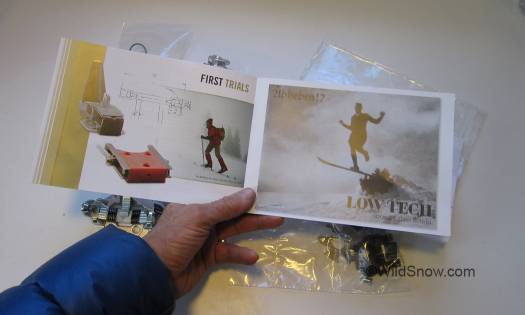This season’s Dynafit Speed Radical ski touring binding is mostly unchanged from previous (2013-2014). The external rotation stop is better integrated and the box includes a brand booklet detailing tech binding history. For true human powered backcountry skiing we still feel this is the sweet spot in Dynafit’s binding lineup. Simple. No monkey business. Only change we’d suggest would be a 3.2 mm shim under the toe (with longer screws and heel riser ‘nubbin’ extender), easy to acquire from B&D ski gear.
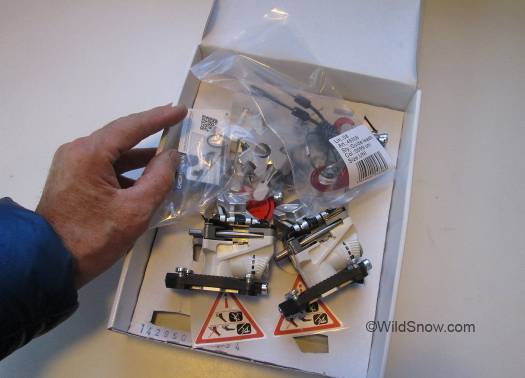
This goody box is not trivial. Overall, you get the impression of a mature product, what with a nice safety leash setup and more.
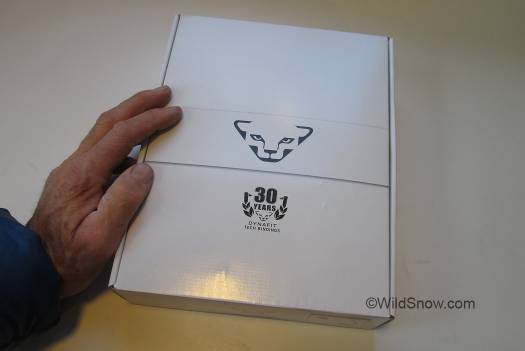
The white box with Dynafit logo could be pretentious — if you were not already the brand leader in backcountry skiing bindings.
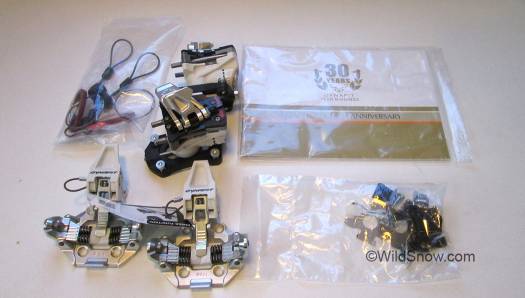
What you get in the ski touring binding box. Leashes at upper left, rotation and crampon attachments at lower right.
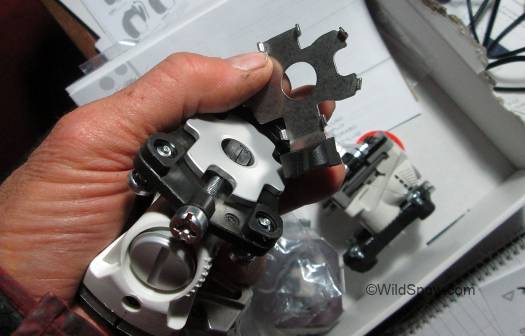
Heel rotation stop is a separate piece you install during the mount. Last season’s version required small washers as spacers, this year the binding base is molded slightly different to allow for the thickness of the extra part.

Looking underneath with rotation stop installed. Arrows indicate thickness of part and extra height in the base molding to compensate for it. Overall increase in height is one millimeter with corresponding weight increase of 12 grams. Note that you can not mount without the rotation stop.
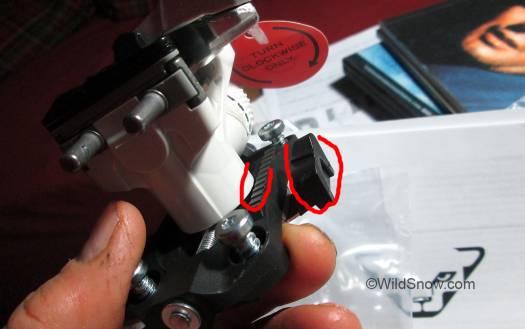
Rotation stopper (circled, to right) with binding in downhill skiing position. It’s not used in this mode. The circle to left indicates a system of notches that Dynafit tried to implement as another method of rotation stop. It worked to some extent, but was not 100 percent reliable.
Use of Speed Radical with the external rotation stop is confusing for newcomers. Graphics and hang tag indicate only rotate clockwise, which is wrong in my opinion, though if forced you can get it to work. The instruction to only rotate clockwise is probably an artifact from a few years ago when Dynafit tried to include an internal anti-rotation pin, which if rotated the “wrong” direction damaged the binding.
Smooth and logical rotation of heel is this: Starting in alpine mode (pins forward), rotate counter-clockwise until the heel lifters are forward and base engages anti-rotation tab. If in touring mode then yes, rotate clockwise to achieve pins forward alpine mode. In other words, ignore the “Clockwise Only” hangtag. Once you own and use a Speed Radical, the heel rotation procedure is obvious though training yourself might take two tries. (Note you can indeed rotate clockwise from pins forward downhill mode. Doing so requires popping the binding housing over the rotation stop and in our opinion places undue stress on the system.)

“Speed Radical heel internals: rotation can go either direction with no issues due to identical aluminum edges (indicated by arrows) the black thimble bushing has to ride over as the heel unit clocks. True, if you rotate clockwise from alpine mode there is indeed a flat land on the left side (looking forward) of the spindle post that the thimble bushing immediately invokes, but that same position can be reached while rotating counter clockwise — without having to jump the heel unit over the rotation stop. Thus, the eternal question for any Speed Radical fan, which way will you rotate?
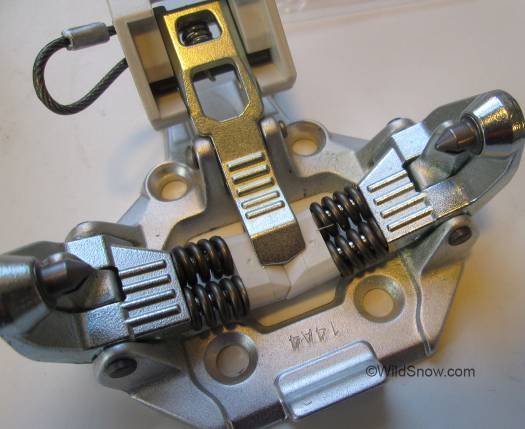
Toe unit means business, includes power towers and what appear to be the ‘grey’ springs that might be slightly stronger than earlier springs.
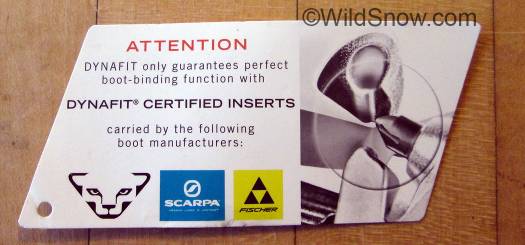
Hang tag indicating importance of compatible boot inserts. Fischer is the new kid on the block. While it’s true official Dynafit inserts may provide more reliable performance out of the box, other brands make good inserts. For example, Scott’s are excellent. Yet in any case, EVERY insert needs to be checked for performance while still on the workbench. Doing so is easy. During your release hand checks, set the heel unit at about 5 for lateral (side) release value. After you check for rattling and play in the boot toe fitting and pin interface (there should be none), with binding in alpine mode and boot inserted, rotate the heel unit with your hand. As you turn the heel simulating a side release, the boot fittings should slide smoothly on the binding toe pins showing the binding has a small but nonetheless real capability for elasticity and return-to-center. If the boot seems to catch and require quite a bit of force to eventually “pop” out of the toe, your boot fittings are probably to blame. For final determination, try other boots in a process of elimination.
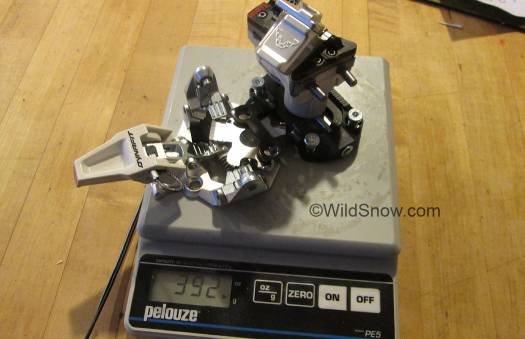
Weight with screws and all other parts is 392 grams total. You can save 8 grams by leaving off the crampon holder bracket, in doing so carefully check length of screws as you may need to shorten the pair that insert through the crampon bracket (depending on ski thickness).
Overall, Speed Radical continues the tradition of simplicity in tech bindings founded three decades ago in the basement of an Austrian farm house; a bauernhaus where harvesting blueberries could easily take priority over the drill press and milling machine. No fooling around with forward pressure springs, no brakes, no hype about TUV and DIN. Mount and go ski tour. No monkey business.
As happens with mature products, at least two companies offer aftermarket mod parts for Speed Radical. Check out Maurelli rotation stop (you can mount it with fixed non-adjustable heel for a delta drop and weight savings) and break-away leash connectors. And let me repeat, B&D has the nice toe shims you want for modern style skiing, along with “Nubbin” heel riser lift kits.
WildSnow.com publisher emeritus and founder Lou (Louis Dawson) has a 50+ years career in climbing, backcountry skiing and ski mountaineering. He was the first person in history to ski down all 54 Colorado 14,000-foot peaks, has authored numerous books about about backcountry skiing, and has skied from the summit of Denali in Alaska, North America’s highest mountain.

